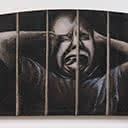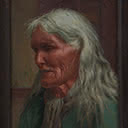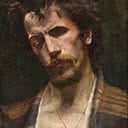View from an Institute Window
55 x 90 cm
PROVENANCE
Private Collection, Auckland
Acquired 1971 from Rue Pompallier Gallery,
Akaroa, by present owner
Robert McDougall Art Gallery, Christchurch,
purchased a work from the above exhibition, the
first institutional acquisition of Fomison's work
REFERENCE
Fomison: What shall we tell them?, Ian Wedde,
(City Gallery, Wellington, 1994) p.184
Tony Fomison (1939 - 90) is widely regarded as one of this country's most important and influential artists, a man who lived and painted on his own terms. This work, untitled by the artist but dubbed View from an Institute Window by a previous owner, is a good example of just how striking his art could be. The painting was most likely completed in 1971 or 1972, a period of personal turmoil for Fomison. Living in a small, dilapidated cottage in Beveridge Street, Christchurch - locals referred to it as 'a street of stray dogs' - he had become a regular user of morphine. It sometimes left him bedridden, unable to eat, and incapable of doing basic household chores. He was paranoid the place was being watched by the drug squad, so visitors had to wait outside to the sound of bolts and padlocks being undone. In July 1970 Fomison was arrested, found guilty of possession and use of opium, and sentenced to six weeks in Rolleston Prison. View from an Institute Window is one of a series of paintings and drawings he made over the next couple of years which had their origins in his time at Rolleston; he later referred to them as his 'institutional' paintings. Although some viewers interpreted them literally - as a comment on the inhumane treatment of prisoners - he hinted that his purpose was bigger than this, and that seems to be the case with View from an Institute Window. Here he uses predominantly black and white to create a dramatic chiaroscuro 'lightbulb' effect, a feature of this period of his career. The dark-light contrast draws attention to the anguished features of the face, the hands pushed against the head, and the bars of the prison. Colour didn't appear often in his work during these Christchurch years (1967-1973) and it wasn't until 1977 that he felt confident enough to complete his 'first all-colour painting', here he has judiciously applied hints of a diluted sky-blue. Is it a comment on the prisons we create for ourselves, the way we treat each other, what it means to be human? We don't know but the intensity and enigmatic quality of his images keeps us looking. Despite his struggles with addiction, Fomison worked diligently. The painting opposite is a good example of the care he took with every part of the process. The backing for the piece is a second-hand arched window frame, picked up during one of his regular sessions of foraging through local abandoned houses. He did this to save money, but also because he had an affection for discarded objects, things society considered outdated or inelegant. Likewise, the inexpensive and readily available hessian, which he stretched and tacked to the back of the window frame. The coarse surface required numerous undercoats of 'polysize', followed by gesso, before it was ready to accept paint. But it also gave his paintings the aged quality he was after - as if discovered in the dusty corner of an attic - and it meant that the material itself was an integral part of the work. When he brushed or ragged on the paint, it 'caught' on the peaks created by the weave of the sacking, leaving flecks of white, like tiny snow-capped hills, as can be seen when you look closely at View from an Institute Window. Made at a time when art in New Zealand was leaning towards abstraction, colour and irony, this work - mostly monochrome, unashamedly figurative and heavy with intent - is a reminder of Fomison's early singular vision for what art could be.
MARK FORMAN





